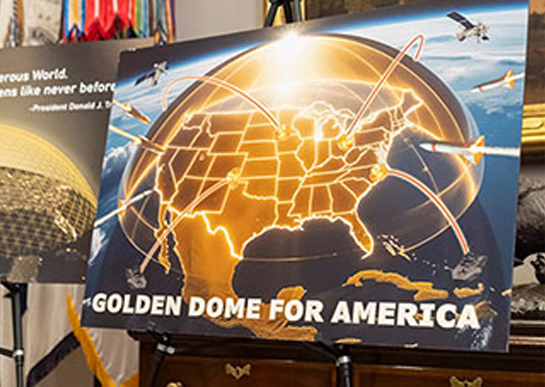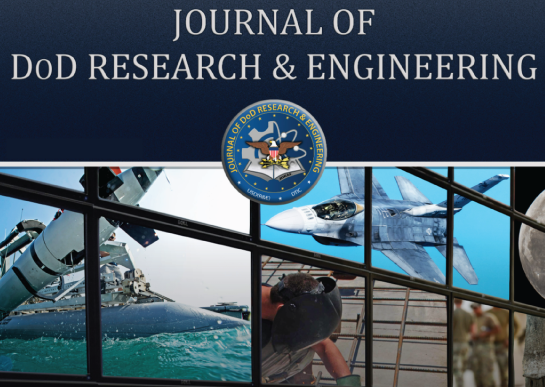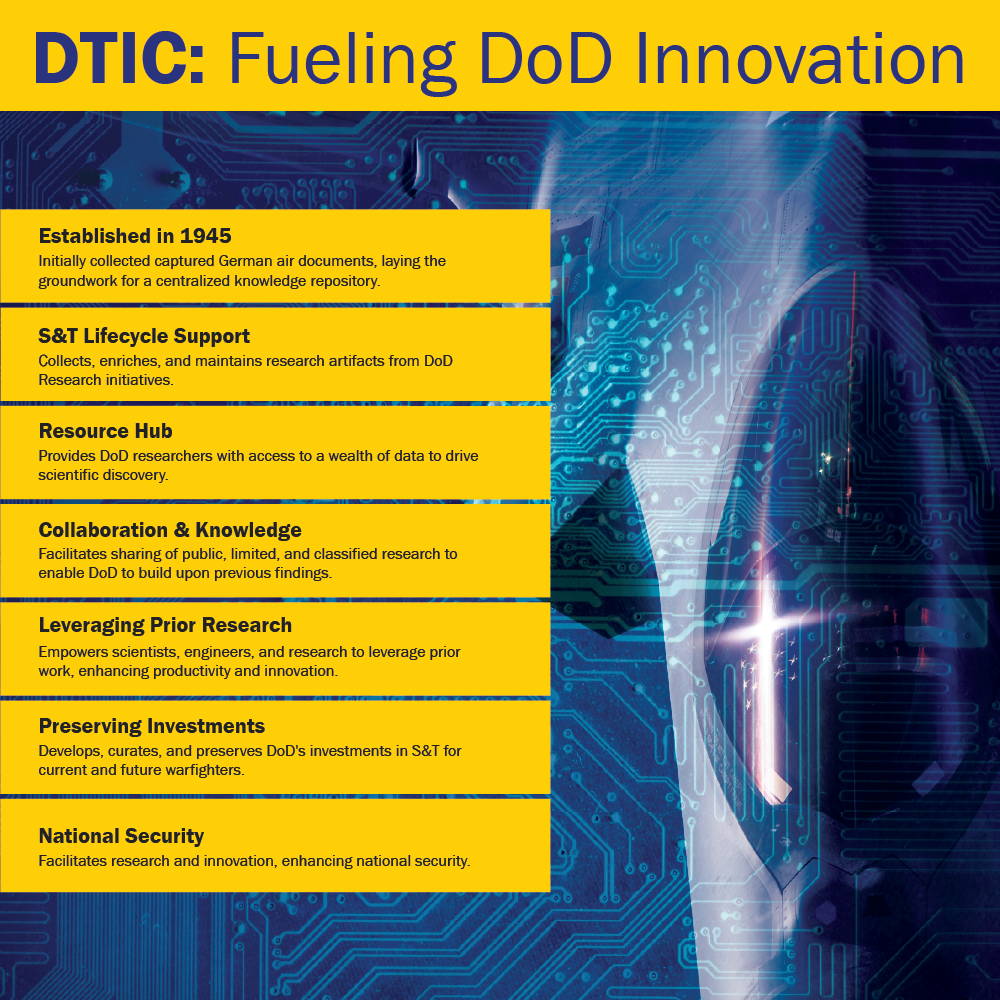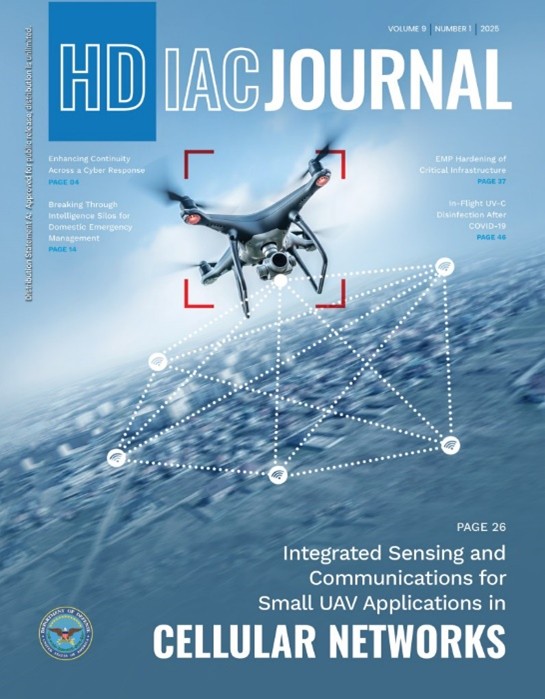Defense S&T Spotlight
July 2025
Defense S&T Spotlight compiles news and updates relevant to DoD and the research and engineering (R&E) community and highlights DTIC resources that will empower you to better analyze, shape, and share your science and technology efforts.
Spotlight Areas
- R&E In The News
- DTIC Products & Services
- DoDIAC
- Quarterly Features
- DTIC Users Council Corner
- News Center
- Defense S&T Spotlight - April 2025
Remember, credentials control the type of information accessible to users.
R&E In The News
In a virtual meeting held June 12, newly appointed Under Secretary of Defense for Research & Engineering, Emil Michael, told the R&E enterprise AI and Quantum are two “North Stars” among the Critical Technology Areas (CTA) that will be an enterprise-wide focus during his tenure.
Those two areas, he said, are common themes or “ingredients” that run throughout most, if not all, of the current 14 CTAs and will help guide him and the R&E workforce throughout his tenure as he pushes to remove barriers allowing people to invent faster.
Statements at the town hall echoed his introductory email to the force. “We will reassess our Critical Technology Areas to sharpen our mission focus and accelerate progress in our selected areas,” he wrote on May 29.
The Under Secretary also discussed his leadership philosophy and core principles. Among them, he said, is loyalty to the mission and the workforce. He stressed that although the R&E workforce is small, it is mighty, and working collaboratively will be a key to speeding innovation successfully.
Explore relevant S&T reports related to this article.
Explore Critical Technology Areas (CTA).
Department of Defense biography for Mr. Emil Michael, USW(R&E) and Chief Technology Officer

The Pentagon is significantly increasing its investments in artificial intelligence (AI) and autonomy in its new budget request, focusing on various drone technologies and AI research.
The Air Force leads the initiative with a request for $789 million to develop collaborative combat aircraft, specifically autonomous wingman drones. Additionally, a new drone swarm program has been introduced for intelligence and reconnaissance purposes.
The Navy is also making substantial investments in autonomous systems, seeking funding for both large and small unmanned undersea vehicles, as well as upgrades to existing drones.
However, concerns remain about the Pentagon's procurement processes, which may result in projects that go over budget and face delays. Experts recommend adopting a more dynamic purchasing model, akin to market systems, to keep pace with rapidly evolving technologies.
This approach would involve regular procurement cycles and adaptability to new advancements, rather than relying on long-term programs. The goal is to deliver capabilities more quickly to warfighters, which may include support for allies like Ukraine.
Explore relevant S&T reports related to this article here.
Source: Defense One

The Pentagon's "Golden Dome for America" is a next-generation missile defense system, estimated to cost $175 billion, aiming to defend U.S. airspace against advanced threats by 2029.
The FY26 budget reveals a comprehensive effort across multiple departments (Missile Defense Agency, Army, Air Force, Space Force, DARPA, etc.) to integrate traditional missile defense with space-based awareness, cyber resilience, and civilian infrastructure. The program encompasses various technologies, including glide phase interceptors, space-based sensors, and directed-energy weapons.
While specific details are still emerging, key defense commands are working on a joint requirements document, and lawmakers are pushing for a consolidated budget overview in FY27.
Explore relevant S&T reports related to this article here.
Source: Inside Defense

A new study by the Center for Strategic and International Studies (CSIS) argues that transitioning from large ground-based radars to a network of smaller passive sensors could enhance U.S. air and missile defense systems and reduce vulnerability to attacks.
The study proposes a hypothetical network for Poland, which would require approximately 400 electro-optical and infrared sensors linked by a robust communications grid. While active radars offer benefits such as all-weather capability, they also emit detectable energy, making them vulnerable.
In contrast, passive systems detect incoming threats without emitting signals, but they face challenges such as weather interference.
The study suggests a hybrid architecture combining various sensor types to optimize performance and adaptability, emphasizing that careful planning, site selection, and robust power and communication infrastructures are crucial for effectiveness.
Explore relevant S&T reports related to this article here.
Source: Breaking Defense
DTIC Products & Services

Use DTIC Horizons to effectively navigate the complex landscape of DoW research and development (R&D) funding and visual designs. DTIC Horizons makes data analysis easy through powerful interactive dashboards and a visual designs. Log in today to access analytics, track budgets, and discover key trends.
Recent enhancements:
- SBIR, STTR, and DoW Grants integrated with USA Spending
- Break out SBIR/STTR funding by service branch in Horizons’ Summary Tab and toggle between DoW and Non-DoW funding sources
- Track technical trends with interactive views of award volume and geographic distribution by Critical Technology Area (CTA)
- Quicky visualize networks of co-authors with a dynamic collaboration graph
- Research funding by country (Summary Tab) provides broader insights into the global distribution of DoW research investments
- Rapidly retrieve saved search results from the Saved Searches page, offering one-click access to interactive analysis across four visualization tabs and simple result clearing via the filter pill

Use your DoD-issued CAC, PIV, or ECA to access DTIC’s R&E Gateway and its extensive collection of controlled-unclassified DoD technical reports and research projects.
Need help signing in or registering? Email DTIC or call 800-225-3842.
DTIC has close to 5 million technical reports and other scientific and technological information in its collection of DoW funded research. Here’s a sampling:
Research offers link between burn pit smoke and serious brain injuries
A forthcoming study from the National Institutes of Health, in collaboration with the Department of War and Veterans Affairs, examines the health impacts of burn pit smoke on nearly 440,000 military personnel deployed in Iraq and Afghanistan between 2001 and 2011. It finds that troops near burn pits face higher risks of mental health issues, including increased rates of depression and traumatic brain injuries, particularly linked to the duration of exposure. For instance, those exposed for at least 129 days showed a 27% higher likelihood of severe stress symptoms, and those exposed for over 474 days had a 200% increased risk of intracranial injuries. While the study highlights these concerning correlations, it cannot definitively establish causation due to gaps in tracking specific chemicals. The findings are set to be published in the Journal of Occupational and Environmental Medicine.
Source: Military Times
GBU-57 massive ordnance penetrator successor in the works
The recent use of GBU-57/B Massive Ordnance Penetrator (MOP) bunker buster bombs by the U.S. Air Force in strikes against Iranian nuclear sites has highlighted ongoing efforts to develop its successor, the Next Generation Penetrator.
Source: TWZ
DoD shows it can reuse hypersonic testbed, setting up faster testing
The Talon-A2 uncrewed hypersonic test vehicle successfully completed its second flight just three months after its initial launch. This achievement highlights its reusability and opens the door for a more rapid pace of hypersonic testing. Unlike previous uncrewed hypersonic test vehicles that typically splashed down in the ocean after depleting their fuel, the Talon-A2 demonstrated a significant improvement by landing on a runway. The vehicle is built by Stratolaunch.
Source: Air & Space Forces Magazine
Army research yields rechargeable battery for extreme operating conditions
The U.S. Army Command, Control, Communications, Computers, Cyber, Intelligence, Surveillance, and Reconnaissance (C5ISR) Center is focused on enhancing the performance of rechargeable batteries used in Soldier-worn and handheld equipment, particularly in extreme temperature ranges. Feedback from field trials continues to guide the Army's research and development efforts, ensuring that the batteries meet the required performance specifications for the conditions where Soldiers operate.
Source: U.S. Army
DoWIAC
Have you read the latest HDIAC Journal?
The latest Homeland Defense & Security Information Analysis Center (HDIAC) Journal features a variety of topics including: Enhancing Continuity Across a Cyber Response, Breaking Through Intelligence Silos for Domestic Emergency Management, EMP Hardening of Critical Infrastructure, and In-Flight UV-C Disinfection After COVID-19. It also highlights:
Integrated Sensing and Communications for Small UAV Applications in Cellular Networks
This article examines the potential of integrated sensing and communication (ISAC) protocols for detecting small, uncrewed aerial vehicles (UAVs). The convergence of communication and sensing technologies presents a unique opportunity to enhance UAV detection capabilities, leveraging existing communication infrastructure and spectrum resources. By integrating radar sensing functionalities with communication systems, these protocols enable localization, tracking, and identification of small UAVs. The cellular communications standardization body, Third Generation Partnership Project (3GPP), is considering adding these capabilities in its future standards specifications.
DoWIAC Journals showcase publicly releasable exclusive articles on new and emerging scientific, engineering, and technical subjects to help you
- Stay up to date with the developments in DoW science and technology
- Understand complex scientific and technical concepts, theories, and applications in defense
- Develop a greater appreciation of a variety of technical focus areas
Access the latest journals
DTIC Users Council Corner
Cast your vote to ensure your voice is represented
The nomination period for the DTIC User Council is now closed, and it's almost time to vote for your FY 2026 representatives. This is your chance to select members who will champion your interests and address the S&T challenges you face as DTIC modernizes its products and services, from submission to discovery.
When the voting period opens, you'll receive guidelines and statements of interest from all 33 candidates vying for the five open positions. These statements will provide valuable insights into their qualifications, priorities, and goals for contributing to the Council.
The DTIC User Council is an independent organization that plays a vital role in advising DTIC. As DTIC continues its modernization efforts, your User Council will be instrumental in shaping key decisions and innovative ideas. Your participation in this election is important to shaping the future of DTIC.
Learn more about the DTIC User Council here and keep an eye out for the ballot here.
Quarterly Features
DTIC is celebrating 80 years as DoD's STI knowledge center
Join us for the third installment of our webinar series commemorating DTIC's 80th anniversary. This session will provide valuable insights on how to maximize DTIC's resources for your research. You will hear from DTIC users within the DoW scientific and technical community as they share their experiences.
A panel of DTIC users will discuss the importance of DTIC to both the DoW and the broader research community. They will cover topics such as:
- How they currently utilize DTIC's resources in their day-to-day roles
- Ways to leverage DTIC's resources to foster innovation and advance the missions of the DoW and their organizations
- Suggestions on how DTIC can evolve to meet the changing needs of the DoW S&T community in the future
When: August 14 at 1:30 p.m. EDT
Register today to secure your spot.
Check out DTIC's YouTube channel to view previous webinars.
Dr. Arati Dasgupta
Naval Research Laboratory (NRL)
Dr. Arati Dasgupta is the Head of the Radiation Hydrodynamics Branch at the U.S. Naval Research Laboratory, specializing in atomic and radiation physics for the Department of Defense. A University of Maryland graduate, she has been with NRL since 1986, focusing on high-energy density physics, atomic and plasma modeling, spectroscopy, and Inertial Confinement Fusion experiments.
Dr. Dasgupta is dedicated to STEM education and mentorship, leading initiatives for young scientists, particularly from underrepresented groups, and holds leadership roles in the American Physical Society and IEEE Women in Engineering. As a Principal Investigator, she has secured significant funding from the DOE and DoD, establishing her group as a leader in plasma physics and national security applications.
Stay updated on the latest U.S. military services' Security Classification Guides (SCGs)
Why waste time searching through multiple websites for SCGs when you can use DTIC's comprehensive one-stop resource? The SCGs help officials determine the appropriate document classification and markings for military systems, programs, plans, and project information.
DTIC's SCG Index has moved and no longer requires an active DoDTechipedia NIPR account for access. If you have a bookmark for the DoDTechipedia SCG page, please update it to the new site.
News Center

JDR&E
Latest Journal of DoW Research and Engineering (JDR&E)
Access the latest volume of the Journal of DoW Research and Engineering (JDR&E), Volume 8, Issue 2. This issue is a regular edition that highlights the work of DoW researchers at the U.S. Military Academy, Naval Postgraduate School, and Air Force Institute of Technology as well as DEVCOM Army Research Laboratory, Air Force Research Laboratory, Naval Research Laboratory, and Army Engineer Research and Development Center. The NIPR version features 15 controlled unclassified articles. The SIPR issue has a classified article that highlights research at the Missile Defense Agency.
Access your copy of the NIPR version of JDR&E issue.
The JDR&E is seeking to expand its pool of peer reviewers and increase article submissions, particularly on NIPR/SIPR topics from all 19 Communities of Interest, to foster collaboration within the DoW R&E communities. Interested individuals can find information on how to apply as a peer reviewer or submit an article on the JDR&E website. Previous issues are available in the JDR&E archives.

R&E Newsletters
CrossTalk: The Journal of Defense Software Engineering – Strategizing with Agility
CSIAC Digest
DSIAC Digest
HDIAC Digest
*Only Distribution A newsletters are shown in this list.
Disclaimers
Featured news articles highlight technology, research, and developments of interest to the S&T and RDT&E communities. Articles may have been abbreviated, synopsized, or excerpted; the full articles can be found by using the links provided within or at the bottom of each article. The views expressed in this online newsletter are those of the originating authors and do not reflect the official policy, position or opinion(s) of the Defense Technical Information Center (DTIC), Department of War (DoW), or the United States Government.
DTIC does not endorse any specific technologies, products, or services featured in or highlighted by any of the articles in this online newsletter. The appearance of external hyperlinks does not constitute endorsement by DTIC, the DoW, or the United States Government of the linked websites, or the information, products or services contained therein and neither DTIC, the DoW, nor the United States Government exercises any editorial control over the information you may find at these locations.
All provided links are consistent with the mission of this website.
Please let us know about any existing external links that you believe are inappropriate.












